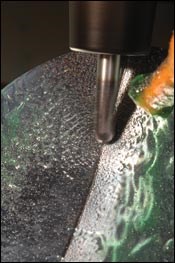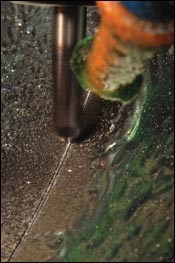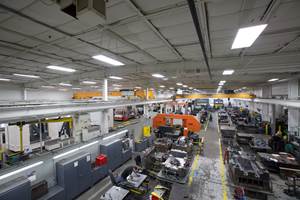VMCs Provide Improved Surface Quality for Eyeglass Lens Molds
Carl Zeiss Vision improves crucial surface quality of its polycarbonate eyeglass lens molds and designed repeatability and added capacity into their metal mold operation.
For decades, scientists, doctors, researchers and engineers around the world have relied on precision-perfect optics from Carl Zeiss. From surgical microscopes and lasers, to telescopes and lenses used in space exploration, to eyeglass lenses, Carl Zeiss is an expert in premium optics.
With U.S. headquarters in San Diego, CA, the company is part of the larger organization, Carl Zeiss Vision International GmbH, headquartered in Germany. Carl Zeiss Vision’s Mexico operation makes stainless steel molds, pours eyeglass lenses and distributes them to customers around the world. They make lens molds for progressive and bifocal lenses, trifocals, small spheres (front and back) and semi-finish single-vision glass.
Recently, Carl Zeiss Vision not only wanted to improve the crucial surface quality of the molds they were producing for their polycarbonate eyeglass lenses, but they also wanted design repeatability and added capacity in their metal mold operation.
Exact Requirements
The stainless steel molds for polycarbonate progressive, single-vision and aspheric lenses that Carl Zeiss Vision’s CZVM2 plant manufactures are an exacting science, due to the requirements for the eyeglasses. But to understand the precision of the molds, one must first understand the types of eyeglass lenses for which they are made.
Polycarbonate lenses protect vision by holding up to rough-and-tumble activity. The polycarbonate material prevents the lenses from shattering. These lenses also are lighter than standard plastic or glass. People with strong prescriptions using polycarbonate lenses won’t feel the heaviness normally experienced with thicker lenses. Polycarbonate material also offers 99 percent ultraviolet protection, and usually comes with a scratch-resistant coating.
Progressive lenses typically are prescribed for older individuals with focusing problems caused by presbyopia, or hardening of the eye’s natural lens. Progressive lenses, sometimes referred to as no-line bifocals, not only provide visual correction for distances that traditional bifocals can’t, but they also hide the fact that you even need reading glasses.
Progressive lenses provide a smooth transition from distance through far to near, with all the in-between corrections included as well. This constant graduation of the prescription means that you can look up to see in the distance, look ahead to view your computer in the intermediate zone, and drop your gaze downward to read and do fine work comfortably close up. Progressive lenses are often made with polycarbonate material.
Aspheric lenses, unlike conventional lenses, have a front surface that is spherical, shaped like the surface of a ball. And aspheric lenses have a more complex front surface that gradually changes curve from the center of the lens out to the edge. This gradually changing surface gives superior vision versus a conventional lens. It also keeps optics crisp and clear—eliminating distortions. It also is lighter and thinner than conventional lenses, reduces magnification of the eye and does not bulge out of the frame as much as regular lenses.
Choosing the Right Machine
Dick Lusignan is technical manager at Carl Zeiss Vision’s CZVM2 plant and has 44 years in the business of making eyeglass molds. He understands the science behind the lenses and the quality expected from his molds. He and his team chose two Makino V33 vertical machining centers to make the polycarbonate progressive, single-vision and aspheric lenses that are cast at their operation.
The Makino V33s are used in milling the finished stainless steel mold surface before polishing and for maintaining the desired optical design. With the V33, they do the final skim cuts on the molds to enhance surface quality and to provide the required quantity of molds to maintain the poly operation.
The files, created with Delcam, are sent to the Makinos, and using a 6-mm Robbjack cutting tool, an aspheric surface is cut over the mold—holding tolerances to within hundredths of a diopter.
A diopter describes the refractive (light bending) capacity of a lens. The optical power of a lens with a focal length of 1 meter (about 39 inches) is said to be 1 diopter. Because the formula is based on the reciprocal of the focal length, a 2 diopter lens is not 2 meters, but 1/2 meter, a 3 diopter lens is 1/3 meter, and so forth.
This is important because magnification increases as the focal length gets shorter, which is why a prescription for a higher diopter correction means you need more magnification.
“Our metal mold operation is in hundredths of diopters of magnification,” says Lusignan. “So we try to take enough time in the mills to give us surface quality and magnification to meet a specific design. We really want to get to near net accuracy on these molds so that there is less polishing, but also so that the polishing does not negatively impact the geometry that has been built into the mold.”
Carl Zeiss attempts to leave the least amount of stock necessary behind for polishing, as to not affect overall accuracy. They do a 0.001 inch skim cut, which is their final pass. The helps them get the mold just right by allowing for better surface finishes and milling the steel in a hardened state.
More Data, Better Surface Finishes
The old method used before obtaining the Makino V33s was low rpm. There were unbalanced toolholders and cutting tools that were cooled using coolant fluids. The new method with the Makino V33s has a 30,000-rpm spindle, laser measurement and HSK balanced toolholders.
“We are processing four times more information than in the past with Makino’s SGI.4. The additional information provides improved surface quality while maintaining the required design,” says Julieta Ramos, engineering manager. “We are getting improved surfaces with the Makino machine.”
“We use the Makinos for skim cuts only,” says Lusignan. “We use the Makinos mainly for the skim cut because of the accuracy and the surface quality that we are getting from those machines. We cannot get the accuracy by hand that we get from the machines. We are capable of taking the Makino from a raw block and doing all three cuts in a hardened state, which is something that we never could do before.
“You have to have good surface finish to even be acceptable to make a lens. And, in trying to do that surface quality, you’re affecting the magnification. So the better the surface is from the mill, the faster you polish the surface and the less you affect the magnification.”
Better Time-to-Market
In addition to the improved surface quality characteristics, the Makino V33s have improved response times on the metal mold deliveries and on milling hardened surfaces.
“With the older processes, we would mill the product—first and second cut—and then send it to an outside vendor for hardening. And then the pieces were returned to us for a skim cut and that took more than 30 days,” says Lusignan.
“Today, we do everything in house and we are capable of sending a new mold, made from a raw block, to our customer within two days. And the hardness is at a 52+ Rockwell range, which is the limit we can achieve in the stainless steel we use for our metal molds.
“The Makino machines have improved surface quality and also have reduced bench times as much as 50 percent. In the old days, it took 10 to 12 hours of polishing. Now it’s down to around five hours.
“Our goal is to make the best surface quality possible,” says Lusignan. “The Makinos have given us that advantage over what we had before. We have tighter curves, smoother surfaces with less lines, and the ability to polish at a 50 percent reduced cycle from what we used to do in the past. This has helped us tremendously in maintaining curve control. And every hour that we can cut off of the polishing cycle improves the surface and improves the magnification.”
Ramos agrees. “The repeatability and precision over time has really impressed me on the V33. The Makino milling machines have decreased leadtimes to our customers. We are capable of milling hardened molds, therefore allowing new molds to be delivered to our customers much more quickly.”
Evaluating Machine Options
Carl Zeiss Vision’s R&D department evaluated milling machines from different vendors and visited many facilities to choose the right machine. The Makino V33 vertical machining center was recommended to them by one of their affiliates for metal mold fabrication.
“I think the demand for polycarbonate lenses will continue to grow,” Lusignan says. “There will always be people out there who prefer to wear glasses, compared to getting eye surgery or contact lenses. So we will always be looking to achieve better surfaces. I think that the use of polycarbonate will continue to increase. And, I see the need for metal molds increasing year to year.”
Using the V33 makes sense for this growing operation. “For us, the choice was easy,” says Ramos. “Carl Zeiss Vision not only has two Makino V33s here at CZVM2, but we also have two more in another facility in Australia. The cost of the machine is justified by volumes, quality improvement and faster service to our customers. We also knew the Makino level of customer service is very good.
“With the V33, we have reduced leadtimes to customers, reduced internal reworks for surface quality, while increasing productivity,” she says.
For Carl Zeiss, better surface finishes mean better lenses, and for both the company and its customers, seeing is believing.
Related Content
Design Strategy Tackles Big and Small Complexity Challenges for Southeastern Mold Builder
Delta Mold Inc.’s core values, engineering expertise, five-axis machines and molding capabilities help the team turn a proposal into a manufactured mold or part with custom design, finishing and assembly.
Read MoreMoldmakers Deserve a Total Production Solution
Stability, spindle speed and software are essential consideration for your moldmaking machine tool.
Read MoreFive-Axis Graphite Mill With Automation Debottlenecks Electrode Machining
Five-axis electrode cutting enabled Preferred Tool to EDM complex internal screw geometry on an insert that otherwise would have had to be outsourced.
Read MoreMachining Center Spindles: What You Need to Know
Why and how to research spindle technology before purchasing a machining center.
Read MoreRead Next
How to Use Strategic Planning Tools, Data to Manage the Human Side of Business
Q&A with Marion Wells, MMT EAB member and founder of Human Asset Management.
Read MoreAre You a Moldmaker Considering 3D Printing? Consider the 3D Printing Workshop at NPE2024
Presentations will cover 3D printing for mold tooling, material innovation, product development, bridge production and full-scale, high-volume additive manufacturing.
Read More


















.jpg;maxWidth=300;quality=90)






